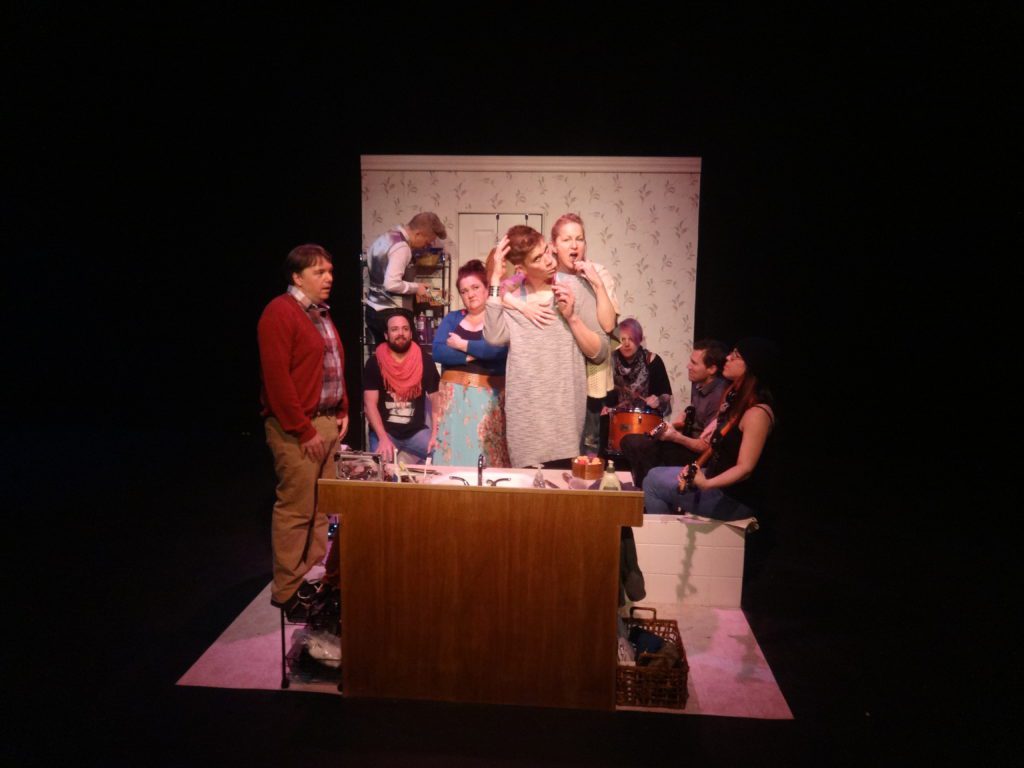The script, developed by the usual collaborative Buntporters (Erin Rollman, SamAnTha Schmitz, Hannah Duggan, Brian Colonna, and Erik Edborg), along with fellow castmates Diana Dresser and Michael Morgan, and musicians Dan Eisenstat, Miriam Suzanne, and Sondra Elby, is interesting, funny at times, thoughtful, occasionally very sad, and challenging. It uses a contemporary interpretation of the myth of Salmacis and Hermaphroditus, a man and woman who are merged to form one being of both sexes. In this production, this is (thankfully) not a special effects-based attempt to merge two people, but a decidedly low tech fusion, with Edborg and Dresser using proximity and direct contact to portray the combination of two into one. The story confronts the audience with the reality of what this sort of merger could really mean to the two people themselves and to their circle of friends. Buntport Theater creates new work in a way unlike anyone else. When they adapt, or interpret, or, as they say about their latest creation, 10 Myths on the Proper Application of Beauty Products, do “more of an extension.” One intrinsic aspect of Buntport’s approach is to be consistent with the nature of the original. The source in this case is Miriam Suzanne’s novel Riding SideSaddle (published under the name Eric M. Suzanne), a box of 250 randomly ordered index cards, each with a snippet of the story. Watching the performance, it is helpful to keep this in mind, to set expectations appropriately. 10 Myths is a series of short scenes which are connected by characters and are clearly part of the same story, but do not follow a clear, logical, linear time sequence, yet still have a nice rhythm, building to a climax appropriately.
The physical space is crucially important to the story, as it always is with Buntport, and nearly all the action takes place inside a small (about 8′ by 8′) bathroom. The entire cast is always present, with those not involved in each scene off to the sides, but the movement outside the bathroom is in slow motion and dimly lit. The tight space constrains everything, with its restrictions causing conflict and necessitating compromise. It also allows for some humor at different levels, including physical comedy, some (literal) bathroom humor, the reality of day-to-day life in front of a mirror that isn’t there, and a three-piece band in the bathtub. But importantly, it also helps connect the audience with the story, making it much more part of the contemporary everyday world, including helping to imbue it with undercurrents of how we define gender.
The acting is spot-on. A pure ensemble piece, none of the actors stands out or dominates, but each creates a unique character important to the story. Diana Dresser is Sam, seemingly sad, but hopeful, merging, then merged, then anticipating the merger with Erik Edborg as Herman. From the start, both are somewhat (for lack of a better word) hermaphroditic, reinforcing the gender combination. The two are fascinating to watch as their fusion ebbs and flows throughout the nonlinear “story.” Hannah Duggan and Erin Rollman are realistic as Jenny and Jolene, a loving couple dealing with physical and emotional challenges. Michael Morgan is hilarious as Edward, compulsive and wonderfully frustrated by the others, but still cared for and appreciated as part of the group. Brian Colonna, labeled “Narrator” in the program, also adds comic relief, is perhaps the most real of the characters, and struggles to fit in with the others.
As with all things Buntport, the scenery, lighting, and costumes are developed in parallel with the production by the collaborative group. This enables a level of integration rarely achieved by other companies with the occasional exception of those with very significant budgets. The concept of a small, constrained bathroom in a wide expanse of blackness is intrinsic to the production. The details in the bathroom are impeccable, and the darkened areas to the left and right provide the perfect periphery for the primary action.
The band provides an appropriate soundtrack to the dialogue and activity onstage, never dominating, but always enhancing. The members of the band also provide an opportunity for occasional surprises when they unexpectedly interact with the characters in the story.
While 10 Myths on the Proper Application of Beauty Products has comedy, it is not as funny as much of what Buntport has created over the years. The focus is more thoughtful, challenging the audience to piece together the story from nonlinear bits and pieces, and to think about gender, and identity, and relationships, and loss. I think I prefer some of the more outrageously funny past productions, but I also do like to be challenged in this way, and appreciate that Buntport is always willing to try new and different material, pushing audiences in new directions.
-Craig Williamson, March, 17, 2016 North Denver Tribune







